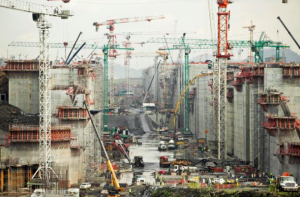The word “Panama” typically brings to mind many things for those who live, work, and travel here. But to most of the world unfamiliar with the Central American nation, the first thing that comes to mind is almost always the Panama Canal. Heralded as one of the wonders of the world, and one of the greatest engineering feats in modern history, the Panama Canal has brought fame, fortune, and future prosperity to a country that’s small, yet incredibly powerful. Just a few years ago, the Panama Canal celebrated its 100-year anniversary, an event that marked many different eras, governments, and both economic and social cycles. Now, a few years after the 100th anniversary and inauguration of the new upgrades, we take a look at why the Panama Canal is more important than ever, and what it will bring to Panama in the future.
Panama’s economy relies heavily on the Canal and its ancillary businesses
The Panama Canal accounts for roughly 40% of Panama’s total GDP, and is the single largest economic driver when it comes to new job creation and new business creation. There are literally thousands of global businesses that rely on the Canal, and each pays a price to use it. There are also a significant number of domestic industries in Panama that rely on the Canal for business, in many different sectors. Ships are charged fees to cross the Canal, scaled based on size and cargo. Around 15,000 ships pass through the Canal each year, making the waterway busy around the clock, all year ‘round.
Aside from the revenues made from crossing charges, the Canal allows Panama to become a hub for import/export trade, making it a key global market for trade in the western hemisphere. Panama has a vibrant trade economy with countries like the United States, Canada, and recently (2018) China. According to the World Bank “The United States is Panama’s most important export destination, with about 24.7% of the country’s exports being destined for the US. Canada and the EU are also major export markets for Panama, accounting for 16.2% and 15.1% of the country’s exports respectively.”
The Panama Canal’s role in the country’s diverse history
Although there are many varying opinions about the positive/negative impact of foreign sovereignty over Panamanian land, the Canal’s history would be incomplete without mentioning it. Initially a French undertaking, the Panama Canal was completed by the United States, with sovereignty granted over the waterway and its immediate surroundings. This introduced an interesting dynamic to Panama, which put tens of thousands of foreign immigrants from all over the world right here in Panama, to help build the Canal, work on it, and work for those who controlled it. Panama’s ethnic diversity was created by this project migration, bringing in many Americans, Chinese, West Indians, and Europeans, who stayed after its completion, and who’s families became part of the fabric of the country’s history.
The future of the Panama Canal
Since the 2014 Panama Canal expansion, business has been growing steadily. Panama can now handle some of the world’s largest ships, allowing them to handle new vessels that facilitate larger, faster, global trade shipping schedules. Panama has also made a strategic partnership with China in 2018, which will bring not only more ships through the Canal, but also drive import/export trade, which will have many benefits long-term for Panama’s economy.
